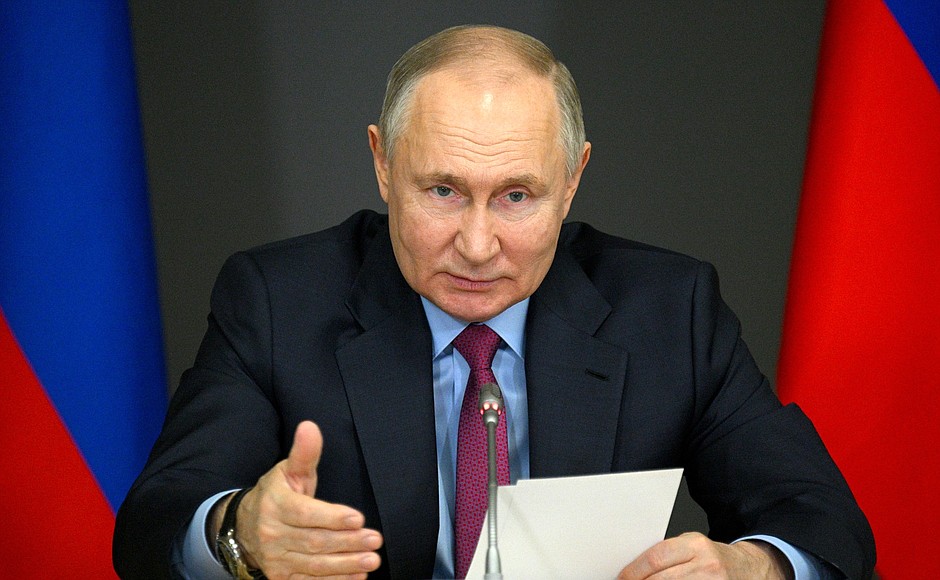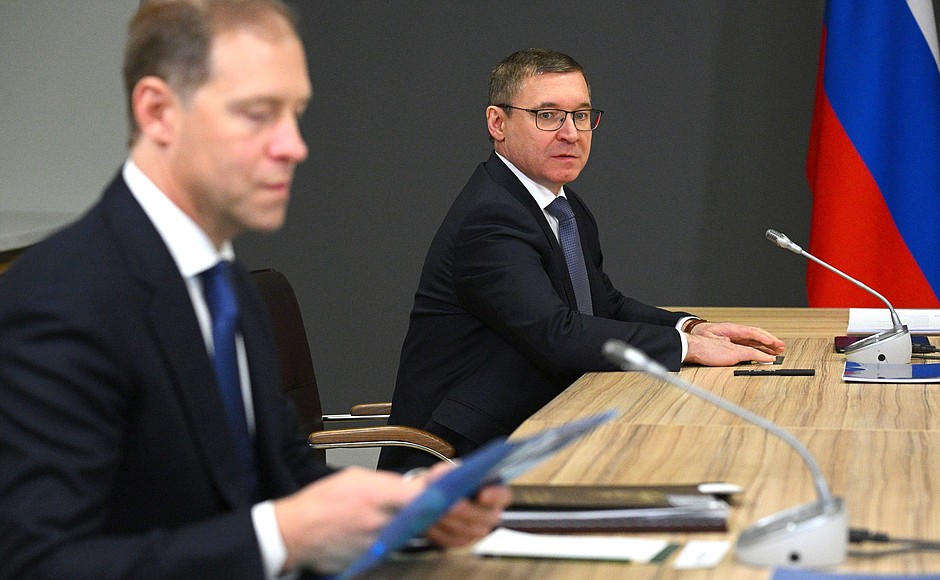President of Russia Vladimir Putin: Good afternoon, colleagues.
We are meeting in Chelyabinsk. Here, in the Urals, in one of our historical industrial regions, we will discuss issues related to the development of industry and decide what additional measures we should take to support individual plants and whole branches of industry to ensure the country’s technological sovereignty and strengthen our workforce, science and production capacity.
Right at the outset, I would like to note that Russian industry is operating stably and developing steadily. Despite the external pressure, we have established new supply channels for raw materials and components and built relations with reliable partners from friendly countries.
Many domestic companies have successfully replaced imported products and developed their own lines of components, machines and equipment, found the necessary personnel, resources and technology, and set up the manufacture of products for market segments in which Western brands prevailed until recently.
I am referring not only to consumer goods of general demand, such as furniture, clothes, footwear, household chemicals, perfume and cosmetics. This also applies to high-tech branches, such as the pharmaceutical industry, machine building, including electrical equipment, aviation and automobile equipment and modern trains.
Last year, KAMAZ launched its new K5 mainline freight lorry. We went to a plant of the Sinara Group that has already started serial production of Finist, a fully domestic high-speed passenger electric train.
Literally, before the start of this meeting, my colleagues and I visited several plants, among them a new factory making industrial robots, which was opened here, in Chelyabinsk. Colleagues told me that they are already developing this promising business and will be carrying out ambitious plans for the future.
We will automate production, introduce digital solutions on a broad scale and, of course, train the workers that will put our industry on an entirely new level and accelerate its growth.
I noted on an earlier occasion that the volume of industrial output in Russia was up 3.5 percent as of the end of 2023 and the manufacturing industries grew by 7.5 percent.
I would like to thank the specialists who work in our manufacturing industry and express words of gratitude to everyone, including workers, engineers, team leaders, and heads of companies, everyone who works in mines and power plants, factories, plants, mills and industry-specific institutes. Their professionalism, responsibility and dedication expand our country’s potential day by day and make Russia stronger.
The Government's goal is to expand the opportunities for domestic industry so that new production facilities and modern well-paying job openings become available across Russia.
We need special mechanisms now that the Central Bank is raising the key interest rate. I hope this is a temporary measure to curb inflation, and we will soon achieve the key benchmarks set by the Government and the Central Bank. For the time being, though, we need targeted support measures and customised mechanisms to support the manufacturing industry.
We have such mechanisms, and the cluster investment platform is among them. Acting within this framework, organisations that launch projects in key industries and produce top priority products can count on soft loans of up to 100 billion rubles which is 30 percent of the Central Bank's key rate plus 3 percent. Investors must put in 20 percent of their own money in the project to take advantage of this.
More than 30 such large-scale integrated projects have been approved to date, and 35 more are in the works.
At the same time, it is important to look beyond the horizon, and invest in creating our own solutions in strategic sectors, such as next-generation transport, even if it does not pay back immediately.
Clearly, this needs support with special terms, and we also know that the Government has offered such terms for some projects. Please do not delay project implementation.
Next, an industrial mortgage programme, which we have discussed many times and worked to fine-tune the terms, has been launched. To buy, build or renovate production facilities, companies can take out a seven-year loan of up to 500 million rubles at an annual interest rate of 3 to 5 percent. More than 800 such loans have already been issued.
Third, subsidised loans from the Industrial Development Fund are also in demand by enterprises and businesses. It has been running smoothly for several years, and the overall experience has been good. With its help, more than 1,500 projects have already been financed for a total amount of about 500 billion rubles. Impressive sum. It is true, though, that businesses say that this is not enough; they are eager to use this tool more widely and expand their production.
I would like to stress that these loans are in demand and needed by our companies. And therefore, I ask you to think about recapitalisaing the Industrial Development Fund.
I understand that these are always difficult issues, especially when all the key parameters of the budget have been agreed upon and launched. But you definitely need to think about this too. I hope that we will have additional revenue.
Overall, we will definitely continue to expand and fine-tune industry support mechanisms. Together with businesses, the scientific community, our enterprises and staffs, we will address specific tasks aimed at strengthening Russia’s technological sovereignty, expanding domestic production, and turning out industrial products.
Of course, we are always talking about this, but producing everything at our own sites is impossible and not even necessary. This is why we intend to expand international industrial and technological alliances, build cooperation chains with our colleagues in the EAEU and BRICS, or anywhere in the world, with other countries and associations that are ready to work together.
At the same time, I would like to emphasise again, I have just spoken at a meeting with people who work at enterprises here on this platform: we need to have our own “technological keys” in areas that are essential for Russia’s security and for improving the quality of life of people; and we will definitely do this. It is important to concentrate both your scientific potential and human resources here.
In this context, let me remind you of the goal we have set. Investments in Russian projects for the manufacture of priority industrial products should amount to at least 10 trillion rubles by 2030. Let us see today how the mechanisms work to solve all the tasks in this key sphere: the development of industry.
Please, Mr Manturov.
Deputy Prime Minister – Minister of Industry and Trade Denis Manturov: Thank you.
Mr President, colleagues,
I am certain that positive dynamics across almost all sectors drove the growth of the manufacturing industry last year. I can provide key benchmarks for the core industries that faced adversity in 2022, if I may.
First, let’s look at the automotive industry, where Government decisions, with your support, have made it possible to boost the output by 13.6 percent. Russian flagship companies are steadily increasing their capacity utilisation, while simultaneously re-launching production sites vacated by foreign companies. Programmes to localise the production of auto parts and components are gathering momentum. Domestic metallurgists, our steelworkers, have fully adapted to new circumstances and increased the output by 5.3 percent, overcoming the downward trend of 2022.
Stabilisation in the industry relies on diversified sales pattern, particularly an increase in shipments to the domestic market, primarily for infrastructure projects and housing construction. Redirecting exports towards Asian, Middle Eastern, and Latin American countries was instrumental in this regard as well.
A similar management model helped recover the chemical industry, with a five-percent growth in output. A 10-plus percent increase in the production of mineral fertiliser was the key factor. Positive developments in low- and medium-tonnage chemistry are notable as well. Eight new production facilities have opened in this segment over the past two years, and about 80 more projects to make innovative products have been funded. Serial production will mostly begin in 2025 and 2026.
We have managed to improve the situation in the timber industry as well. To help them reroute their exports, we subsidised transport costs in the amount of 11 billion rubles, primarily, for producers in northwestern Russia. Combined with other measures, this led to double-digit growth rates in timber processing starting in the second half of 2023. Furniture production increased by over 30 percent during the same time.
All of the above has helped our industries get growth back on track, and they are now focused on achieving the technological sovereignty goal you have set. Unprecedented measures to support investment are proving helpful, too. Last year, the total budgetary investment in R&D exceeded 155 billion rubles. We have never appropriated that much to develop innovations. Similarly, the Industrial Development Fund issued a record-high amount of loans, 142 billion rubles.
Last year marked the beginning of practical implementation of the innovative system mechanisms initiated by you, primarily, the cluster investment platform that you mentioned earlier. Last year, this tool created conditions for investing an additional 730 billion rubles or so into the manufacturing industry.
The recipients of subsidised loans include companies from the metallurgical and chemical industries, the pharmaceutical and automotive industries, transport, energy, and oil-and-gas machine building. Projects totalling 1.4 trillion rubles are undergoing due diligence. The demand for industrial mortgage loans is high. Businesses used low-cost mortgage loans to buy nearly 4 million square metres of production facilities.
Mr President, it is crucial to keep this mechanism working, especially since small and medium-sized companies that take part in the projects pursued by major businesses benefit from it the most. For them, industrial mortgages are the fastest way to buy and, most importantly, to expand these capacities and production areas, including by acquiring ready-to-go industrial park sites. Along with industrial technoparks, this format of industrial growth in the regions is successfully scaling up as well, with 280 such sites now operational nationwide. Investments by residents in these sites have exceeded 2 trillion rubles over the past ten years. We are continuously expanding this infrastructure in collaboration with the constituent entities.
Mr President, the above mechanisms have significantly boosted investment activity. The final figures are being compiled, but, tentatively, the past year is expected to show growth of about 10 percent. I believe this is a good foundation to build on.
According to the Prime Minister's instructions, the main goals are consolidated in key national technological projects. In particular, we focus on cross-cutting areas that are crucial for the entire industry, primarily radio electronics which will receive our special attention with over 210 billion rubles allocated to expand it in this year's budget, including support for electronic engineering, which is essential if we want it to become a technologically sovereign industry.
The manufacturing of the means of production is another critical foundation for almost all of the manufacturing industry. Today, the participants of a meeting with industry leaders identified industrial robotics as a priority for our manufacturing companies. A wide range of machinery, machining centres, and tools are important as well. I reported to you about this in detail last October. We will work on integrated competency development at specialised centres created at Innopolis. The Robot Factory you visited will be the industry’s flagship production facility. Also working as part of the national projects, we are promoting the industries that ensure food, energy, information, and biological security. Of course, we continue to work towards increasing the economic connectivity of our country.
Before concluding my report, I would like to reiterate that we must by all means preserve the level of support for the manufacturing industries that is not inferior to that provided in 2023. This will help us overcome difficult issues and respond to the challenges that lie ahead.
Mr President, in closing, on behalf of the entire industry and all sectors, I would like to thank you for your attention and support. We are confident that we will achieve the goals that you have set for us.
Thank you.
<…>

